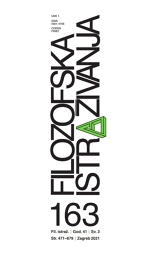Što slike znaju? Umjetnost, aproprijacija, kulturalna triangulacija
What Do Pictures Know? Art, Appropriation, Cultural Triangulation
Author(s): Krešimir PurgarSubject(s): Visual Arts, Epistemology, Aesthetics, Phenomenology, Sociology of Art
Published by: Hrvatsko Filozofsko Društvo
Keywords: image; appropriation; cultural triangulation; image memory; William John Thomas Mitchell; Horst Bredekamp; Michele Cometa; David Freedberg;
Summary/Abstract: In the paper, we try to elucidate the procedures that need to be applied if we want to establish the consequences that occur when the sediments of meaning in images are deposited on top of each other, creating a specific pictorial epistemology. We will point out some interdisciplinary mechanisms of image analysis, such as “cultural symptomatology” and “cultural triangulation”, together with drawing a typology of cultural-historical sediments of pictorial meaning that we call appropriation. We conclude that Bredekamp’s theory of image acts, as well as Mitchell’s concept of pictures as “desiring objects” and Belting’s consideration of the human body as “image media”, suggest that the interaction between a human and an image is a mirror of human’s own desire to produce a parallel world in which, as Lambert Wiesing explained, he or she does not have to participate. The image allows for different forms of participation or absence from participation in the event represented in the image. Therefore, what images “know” is a specific consequence of the fact that inanimate pictorial objects can possess memory but – unlike artificial intelligence – can activate their knowledge only in a reciprocal communicative relationship with people.
Journal: Filozofska istraživanja
- Issue Year: 41/2021
- Issue No: 03/163
- Page Range: 513-530
- Page Count: 18
- Language: Croatian

